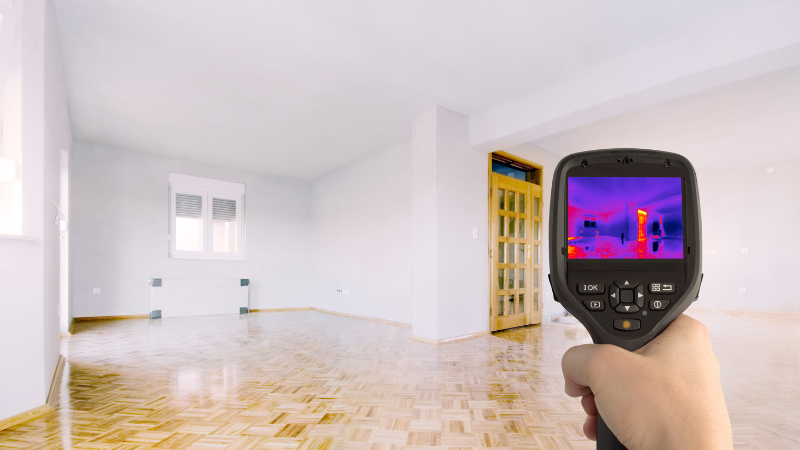Your Cart is Empty
📱GOT QUESTIONS? GIVE US A CALL ON +61 8 7083 9862📱
📱GOT QUESTIONS? GIVE US A CALL ON +61 8 7083 9862📱
INDUSTRY
ABOUT US
Thermal Imaging Cameras Diagnosing Building and Construction Issues
by Curtis Treloar April 08, 2023 3 min read

Thermal imaging cameras have become a popular tool in many industries, including building inspection and construction. They use infrared technology to capture images of the heat signature of objects and surfaces, allowing users to identify temperature differences and potential problems that may not be visible to the naked eye. In this article, we will address some of the most common questions related to thermal imaging cameras in this below blog.
What is the best thermal imaging camera for building inspections in Australia?
When it comes to building inspection, the best thermal imaging camera will depend on the specific needs of the user. Some popular options include the FLIR E6-XT, FLIR C3, FLUKE PTI-120, FLUKE TIS55, testo 883, testo 868 and testo 871. These cameras offer high-resolution images and are easy to use, making them ideal for building inspection professionals.
What is thermal imaging used for in construction?
Thermal imaging is commonly used in construction to identify energy loss, moisture intrusion, and potential electrical issues. By capturing thermal images of a building's envelope, construction professionals can identify areas that need improvement to increase energy efficiency and prevent future problems. It is important to use a secondary tool when identifying certain issues such as moisture, this would include using a moisture meter.

Can thermal cameras see through buildings?
Thermal cameras cannot see through buildings, as they are designed to detect heat signatures of objects and surfaces, not to penetrate through them.
How do you block thermal imaging on a building?
There are many ways to block thermal imaging on a building, including using insulating materials such as fiberglass or foam, installing reflective surfaces, and using materials with low thermal conductivity such as wood or plastics. Additionally, using shading devices or creating air gaps can also help to reduce heat transfer and prevent thermal imaging.
Can a thermal camera see through concrete?
No, thermal cameras cannot see through concrete as it is a dense material that blocks infrared radiation.
Is there a thermal camera that can see through walls?
No, there is currently no thermal camerathat can see through walls. Thermal cameras detect the heat signatures of objects and surfaces, but they cannot penetrate through solid materials such as walls.
What material can block thermal imaging?
Materials with low thermal conductivity such as wood, plastics, and ceramics can block thermal imaging. Additionally, using insulating materials or creating air gaps can also help to reduce heat transfer and prevent thermal imaging.
Can a thermal camera see through floors?
Thermal cameras can detect the heat signatures of objects and surfaces through floors, but they cannot see through solid materials such as concrete or wood.
What is the disadvantage of thermal camera?
One of the main disadvantages of thermal cameras is that they cannot provide detailed images of objects or surfaces, as they only capture heat signatures.
Thermal imaging camerashave become an important tool in many industries, providing users with valuable insights into potential problems that may not be visible to the naked eye. From building inspection to construction, electrical maintenance, and law enforcement, thermal imaging cameras offer a non-invasive and effective way to detect and diagnose a range of issues.
What is the difference between thermal imaging and infrared?
Thermal imaging and infrared are often used interchangeably, but they are not the same. Infrared refers to the wavelength of light that is beyond the visible spectrum, while thermal imaging is the process of using infrared technology to capture and display images of heat signatures.
Can I use my phone as a thermal camera?
Yes, there are several thermal imaging camera attachments available for smartphones, such as the FLIR ONE.

What is a thermal imaging camera used for in general?
Thermal imaging camerasare commonly used in building inspection, construction, electrical maintenance, and law enforcement. They are used to identify potential problems that may not be visible to the naked eye, such as energy loss, moisture intrusion, and electrical issues.
It’s important to note that thermal imaging cameras do have some limitations. They cannot provide detailed images of objects or surfaces, and they require proper training and expertise to use effectively. Additionally, thermal imaging cameras can be expensive, making them inaccessible to some users.
In conclusion, thermal imaging cameras are a valuable tool for anyone looking to identify potential issues related to heat transfer, moisture intrusion, and electrical problems. With a range of options available on the market, users can find a thermal imaging camera that meets their specific needs and budget. However, it's important to understand the limitations of thermal imaging cameras and to use them in conjunction with other tools and methods to ensure the most accurate results.
As always, if you have any questions, please reach out to Advanced Tools.
And of course, don’t forget to browse our range of Thermal Camera’s
